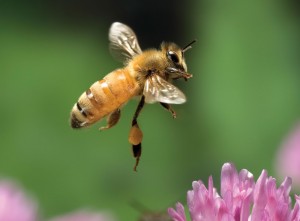 Choose a location in full sun and, if possible, in the shelter of a wall or large shrubs. Fill the bed with a variety of native plants or a mix of natives and old fashioned cultivated favorites that are high in nectar. Use long blooming annuals and shorter blooming perennials so there is an unbroken sequence of nectar to feed the pollinators from early spring until they hibernate or migrate in the fall. Everyone should have fragrant winter honeysuckle. It starts blooming in the middle of winter and blooms to May, feeding bees early. Others include bee balm, trumpet vine, abelia, beauty bush, scarlet salvia, blue salvia, flowering tobacco, primrose, evening primrose, wiegelia, lily of the valley, single petunia, morning glory, nasturtium, snapdragon, floxglove, fuschia, pineapple and common sages, impatiens, poppies, & red clover.
Choose a location in full sun and, if possible, in the shelter of a wall or large shrubs. Fill the bed with a variety of native plants or a mix of natives and old fashioned cultivated favorites that are high in nectar. Use long blooming annuals and shorter blooming perennials so there is an unbroken sequence of nectar to feed the pollinators from early spring until they hibernate or migrate in the fall. Everyone should have fragrant winter honeysuckle. It starts blooming in the middle of winter and blooms to May, feeding bees early. Others include bee balm, trumpet vine, abelia, beauty bush, scarlet salvia, blue salvia, flowering tobacco, primrose, evening primrose, wiegelia, lily of the valley, single petunia, morning glory, nasturtium, snapdragon, floxglove, fuschia, pineapple and common sages, impatiens, poppies, & red clover.
Honeybees have somewhat shorter tongues than bumblebees. Even so, they can work a variety of the above mentioned flowers and like butterflies and moths also feed on the flower heads of tightly packed clusters of tiny inflorescences. These plants include butterfly weed and other milkweeds, Abelia, butterflybush, Joe Pye weed, Sweet William, lantana, lilac, thistle, knapweed, viper’s bugloss, hawthorn, hydrangea, spirea, goldenrod, phlox, heliotrope, penta, sweet alyssum, yarrow, dandelion, staghorn sumac, thymes, mints, oreganos and white clover.
Single flowered favorites include clematis, purple and yellow coneflowers, coreopsis, aster, zinnia, hollyhock, calendula, native sunflower (Helianthus), Mexican sunflower (Tithonia), cornflower, Gaillardia, daisies (gloriosa, painted, Shasta, ox eye), blackberry, chrysanthemums, multiflora roses, old fashioned roses, tomato, eggplant & strawberry.
Trees and shrubs that provide pollen and/or nectar early in the season include tulip poplar, dogwood, cherry, plum, pear and other fruit trees, blueberry, barberry, andromeda azalea, mountain laurel, boxwood, holly, viburnum, daphne, witch hazel, red maple and willow.
Some cacti and succulents deserve a place in your bee garden . They are reliable nectar and pollen sources. They are quite drought-resistant, and like good drainage and full sun. While most are evergreen, certain species are herbaceous. These plants are generally grown from seeds, cuttings and offsets. Cacti and succulents for bee gardens include the following species, many of which are native to America.
Adam’s Needle (Yucca spp.), Aloe (Aloe spp.), Century plant (Agaves spp.), Hottentot Fig (Carpobrotus spp.), Moss rose (Portulacca grandiflora), Prickly pears (Opuntia spp.), Red Yucca (Hesperaloe spp.), Spurge (Euphorbia spp.), Stonecrop (Sedum spp.)
